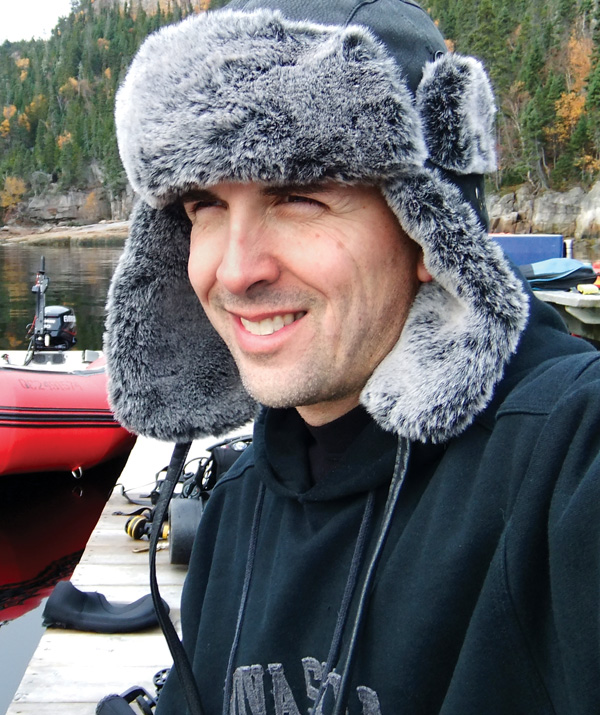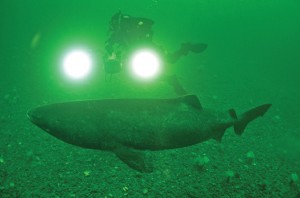
Sharks have been in the public awareness in recent years, largely due to the problem of shark finning and the resultant dramatic decline in shark populations around the world. However, most shark research has been geared towards the more well-known species, such as Great Whites, Makos and Pacific Blue sharks. Species of sharks such as the rarely seen Greenland shark, which is found in the Arctic, have not been on the radar of most shark research institutions.
Jeffrey Gallant is Director of the Shark Research Institute (SRI Canada) and the Greenland Shark and Elasmobranch Education and Research Group (GEERG). Gallant and GEERG have been at the forefront of research on a little known–outside of Canada–species of shark: the Greenland Shark (Somniosus microcephalus), which for many years, was known mainly through fishermen stories and Inuit legends.
He is also Director of the Shark Observation Network, which is relevant for California divers, since it allows any diver, anywhere in the world, to log their encounters with sharks onto a global shark sightings network (www.sharksonline.net).
The Shark Observation Network (www.sharksonline.net) is a partnership of the Greenland Shark and Elasmobranch Education and Research Group (GEERG), the Shark Research Institute (SRI Canada), and BIOAPP. The network supports the collection and organization of data, as well as the development and dissemination of information concerning the state of shark and elasmobranch populations and their worldwide distribution.
Jeffrey started diving with the Royal Canadian Sea Cadets in 1982 at the age of 14. He has since led several research and training expeditions around the world. Among other accomplishments, Gallant was trained as an aquanaut in Romania in 1995, he is the former Chief Diver of the Quebec Aquarium, and he spent a few days diving aboard Cousteau’s wind ship Alcyone in 1999. An award-winning underwater photographer and videographer, Jeffrey has contributed to several dive publications, books, as well as television and film documentaries on sharks and diving, including National Geographic, Discovery Channel, History Channel, and the BBC. He is the author of the internationally-acclaimed Diving Almanac and Book of Records and he has been a contributing editor of Vancouver-based DIVER Magazine since 1997. He was elected a Fellow of the Explorers Club in January 2010. Jeffrey lives in Drummondville, Quebec, where he teaches at the local CEGEP (university prep).
 Several California companies have partnered with Gallant: Ocean Technology Systems (OTS), Diving Unlimited International (DUI), Force Fin and Nocturnal Lights.
Several California companies have partnered with Gallant: Ocean Technology Systems (OTS), Diving Unlimited International (DUI), Force Fin and Nocturnal Lights.
Interview with Jeffrey Gallant
You have been diving since the age of 14 and you are Managing Director of the Shark Research Institute (SRI Canada) as well as Director of the Shark Observation Network. You are the Editor of the Diving Almanac & Book of Records, an Executive of the Canadian Association for Underwater Science and a Fellow in the Explorers Club — but you are probably best known for your interest and research in the Greenland Shark (Somniosus microcephalus) and for the founding of the Greenland Shark and Elasmobranch Education and Research Group (GEERG).
Q: How did you first become interested in this species of shark?
A: My interest in the Greenland shark started at a dive jamboree in 1996. The speakers all got together one night and shark researcher Aidan Martin got me hooked. Then I met Chris Harvey-Clark, a marine biologist who had read about sharks that had been caught in Quebec’s Saguenay Fjord in the 70s. So I started driving around the fjord to interview fishermen and the locals about sharks in the fjord and determined that this was indeed a Greenland shark hotspot. This eventually led to two ice-diving expeditions during which the temperature reached as low as -50°F. Locating an accessible study population of Greenland sharks was our biggest challenge. Prior to work by GEERG, most observations of Greenland sharks had been as fisheries by-catch. In the late 90s, an American team filmed the Greenland shark in the Arctic near Baffin Island. However the logistics and costs of working with this species in the Arctic remained daunting and a study site closer to central Canada with good infrastructure was as elusive as ever.
Q: Is it true that the meat of this shark is toxic to humans due to the presence of high amounts of urea? Isn’t there an Inuit legend about this?
A: The Greenland shark was well known to some of the Inuit peoples of Canada’s Arctic, Greenland and Scandinavia, who captured it through ice holes using bait and lanterns as a light attractant. Once lured to the surface, the sharks were harpooned or simply hauled from the water. The Inuit used the hide, teeth and flesh, and called the shark “Skalugsuak.” In Inuit legend, the shark was formed from a urine-soaked rag used to wash an old woman’s hair that blew from her head, fell into the sea and swam away in the form of the shark. The Inuit noted the shark’s pungent smell, and that dogs fed shark meat became intoxicated and even died on occasion. This poisoning is due to very high levels of trimethylamine oxide, an osmotically active product of nitrogen metabolism found in high concentration in the shark’s flesh where it is neurotoxic when eaten. In more modern times, people in Iceland learned to ferment shark meat to destroy the toxin, and this “shark cheese”, called Hákarl, is a pungent and prized delicacy that is washed down with an equally potent liquor called Brennivin.
 Q: With a distribution from the Arctic Ocean and Northern Europe to the 32nd parallel north in the Atlantic Ocean, including the St. Lawrence Estuary and Saguenay Fjord, and its preference for extremely cold water (-0.6°C to 10°C), is it accurate to say that the Greenland Shark is the only true ‘Arctic shark’?
Q: With a distribution from the Arctic Ocean and Northern Europe to the 32nd parallel north in the Atlantic Ocean, including the St. Lawrence Estuary and Saguenay Fjord, and its preference for extremely cold water (-0.6°C to 10°C), is it accurate to say that the Greenland Shark is the only true ‘Arctic shark’?
A: No. The Greenland shark has been observed at the highest latitudes of any shark species but the Pacific sleeper shark also inhabits areas north of the Arctic Circle. Rare occurrences involving other species have been reported. The distribution of both the Greenland shark and the Pacific sleeper shark is far-ranging, hence no shark species are exclusive to the Arctic Ocean.
Q: What are you currently researching about the Greenland Shark and why is it important?
A: My current project at the University of Quebec focuses on how environmental conditions influence the Greenland shark’s daily movements using diver-deployed acoustic telemetry. As the Arctic ecosystem and its mammal assemblage changes with global warming, it is likely that the Greenland shark, because of its high trophic level, may represent a sentinel species in Arctic ecosystems. We’ve also learned much about its behaviour. In the years since 2003 when GEERG first studied this unusual population in the boreal St. Lawrence River, our thoughts on this species and its ecological role have continued to evolve. This animal is not the sluggish carrion feeder that it was long thought to be. It is perhaps more like a ‘hyena of the sea,’ both a scavenger and, under the right circumstances, a predator. On one shallow dive with near-zero visibility in 2004, Chris and I had a hair-raising encounter when we unexpectedly head-butted with a 15-foot female in stealth mode. “So this is how they take out adult grey seals,” we said after the dive…
 Q: How did the Shark Observation Network idea come about?
Q: How did the Shark Observation Network idea come about?
A: I compiled shark distribution data on Excel files for years until I met Blaise Barrette, the creator of the Underwater Observers Network (ROSM), an online database where divers can report species observed underwater. Blaise and I often talked about how useful a similar network for sharks and elasmobranchs would be for sport divers and scientists, and the Shark Observation Network was born last October.
Q: How can divers enter their encounters with sharks in your network?
A: Divers need to sign up before they can post their shark sightings. The website is user-friendly, so once you are a member, all that’s needed are a few simple clicks to select observation categories and details so posting an observation normally takes around two minutes. If you’re not sure what species you saw during your dive, there is also an interactive shark identification key that can help you make the right choice. Your observation is immediately visible for all users of the network, including non-members.
If you’re diving in California waters – or anywhere – and have an encounter with a shark, take a moment to report the sighting onto the Shark Sightings Network (www.sharksonline.net). There’s also a lot of other interesting and useful information on the site for anyone interested in shark sightings worldwide.
—————————————————————-
Article written by Michael Bear
Photos by Jeffrey Gallant/GEERG
While not a shark researcher himself, Michael Bear is an experienced diver with 1000 cold-water dives in California. He is currently an AAUS [American Academy of Underwater Sciences] Science Diver. He also runs the Sevengill Shark Sightings website in San Diego [http://sevengillsharksightings.org], recently linked to the Shark Online Network [www.sharksonline.net].
Read this and many other great stories and features in our May/June 2011 issue of California Diver Magazine!
Click here to subscribe today!
